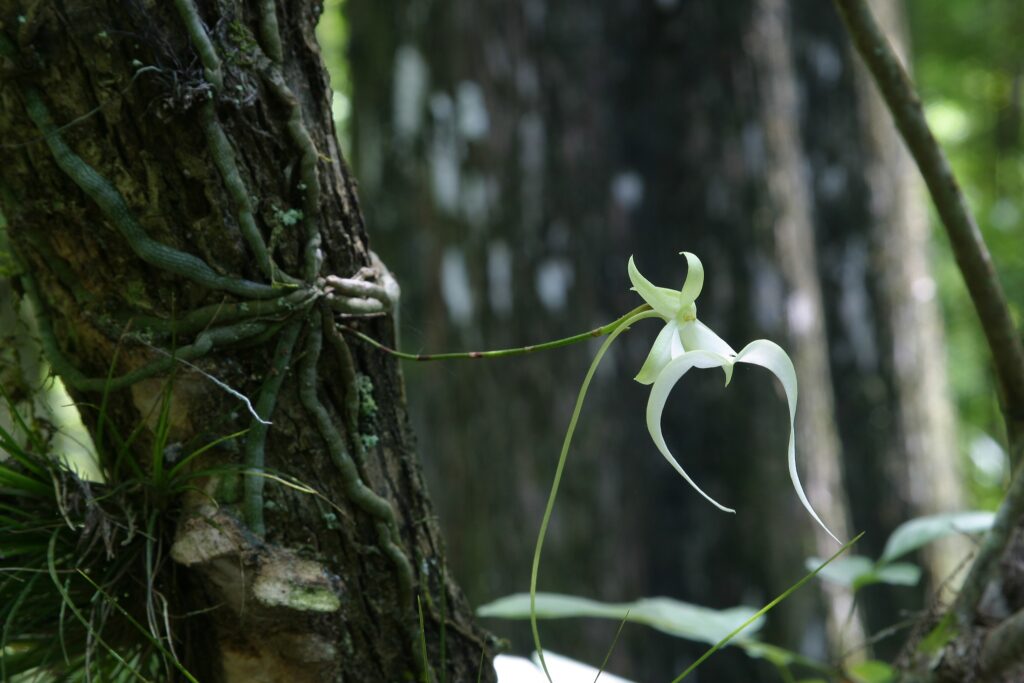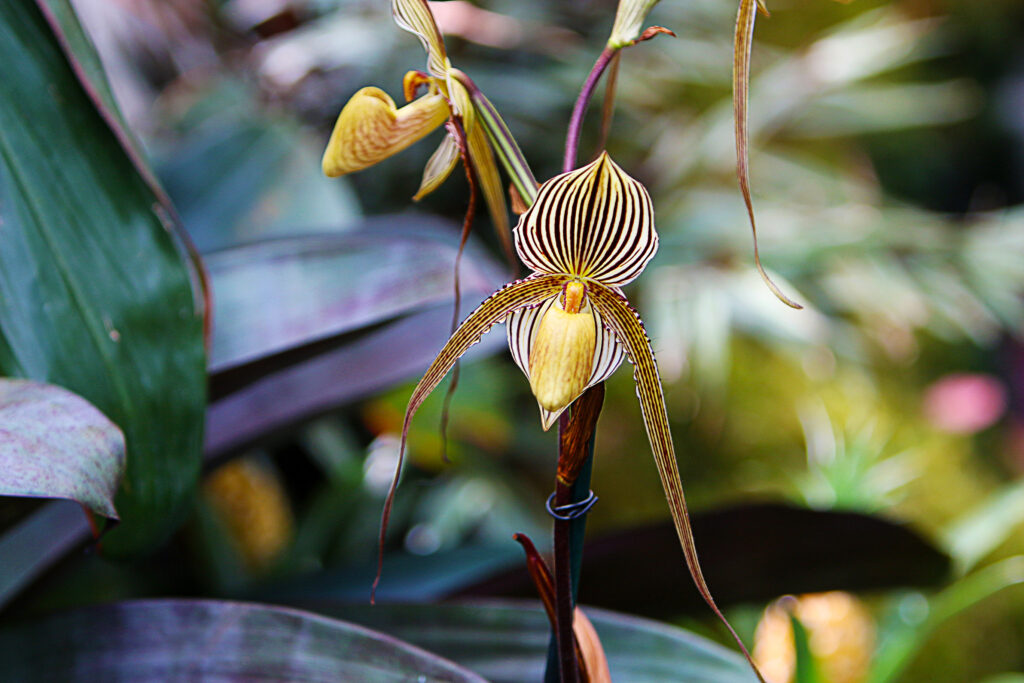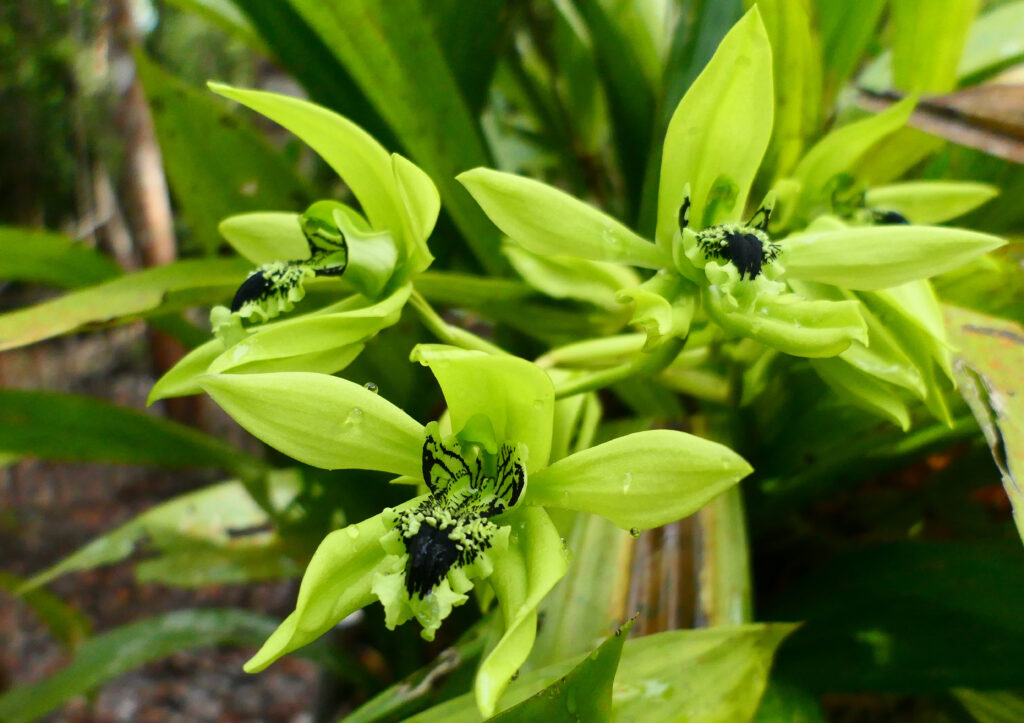Finding a rare orchid to add to your collection is always an exciting undertaking. If you’re new to orchid growing, you might think that rare orchid cultivation must stay in the realm of master gardeners. However, there are actually rare species that are pretty simple to grow!
In this guide, we’ll cover orchid botanical classification and introduce three rare species, their morphologies, native growing ranges, and specific care requirements.
So, without further ado, let’s jump in!
Orchids: Botanical Classification
Orchids all belong to the Orchidaceae family, a stunning, fascinating, and highly diverse group of plants that currently represents the world’s second-largest family of flowering plants. These plants are masters of adaption and mimicry, produce exquisite fragrances, and feature an enormous range of intricately-shaped and colored blooms.
Three Rare Orchid Species
You may be wondering what causes an orchid species to be rare. Often, the answer is the species is endangered due to habitat loss and over-collection. Sometimes, the plant experiences low pollination as a singular factor or in combination with the above man-made issues. When adding endangered species to your collection, it’s critical to ensure you’re obtaining them from ethical sources that aren’t contributing to the plant’s demise in the wild.
You may find that rare orchids are often out of stock, so you might have to be patient in your search. In this guide, we’ll discuss the following three species:
- The Ghost Orchid (Dendrophylax lindenii)
- The Gold of Kinabalu Orchid (Paphiopedilum rothschildianum)
- The Lute-Shaped Coelogyne (Coelogyne pandurata)
Below, we’ll delve into the unique characteristics of each species and their corresponding care requirements.
1. The Ghost Orchid (Dendrophylax lindenii)
Aptly named for a species so aloof, the ghost orchid (Dendrophylax linden) only grows natively in moist forested areas of Cuba, parts of the West Indies, and three southern counties in Florida. Due to its endangered nature, scientists are studying the pollination ecology of this beautiful orchid in hopes of helping to keep this species from extinction.

Ghost orchids grow in only a few locations throughout the world.
©Francisco Blanco/Shutterstock.com
Morphology
Not only is this species quite elusive (like our proof of the paranormal), but the showy white flower also appears to eerily float in mid-air as the plant is usually leafless and the roots are well camouflaged. Since this species rarely produces any leaves, the roots of this wonderfully strange epiphytic orchid actually photosynthesize.
Some people also refer to Dendrophlyax lindenii as the “white frog orchid” due to the shape of the labellum. While the white-to-white-green sepals and lateral petals are narrow and linear, the starkly white labellum is quite eye-catching and uniquely shaped. The uppermost part of the petal drops down in a pyramidal manner. From there, the petal separates into two gorgeous, spindly sections that look remarkably like elongated frog legs. While the flower is typically about 1.5 inches wide, it often reaches almost 5 inches long due to its tendril-like labellum.
Rarely, the ghost orchid may produce one to two bract-like leaves. But generally, it produces no leaves and relies on its green-gray photosynthesizing roots. So while the flower is showy and magnificent, once you notice the roots, you’ll see they are also succulent-like and beautiful.
The ghost orchid tends to only produce one flower at a time between June and August, producing a strong fragrance at night that attracts its long-tongued moth pollinators.
Plant Care
Dendrophlyax lindenii is both rare to find in nature and in cultivation as this plant is rather difficult to grow, especially from seed. However, you can find reputable nurseries that successfully cultivate this plant from seed. This is the best way to obtain and try your hand at growing the ghost orchid. We’ll discuss the care detail for this tricky orchid below.
Watering
Watering year-round is essential for the ghost orchid as it does not contain water-storing pseudobulbs. If this plant is left to dry out, it will quickly perish. In the wild, this species relies heavily on the moss and lichen its roots are interwoven through to help retain moisture during drier periods.
You’ll want to water year-round to ensure the growing substrate and roots never dry out. A properly draining and aerated substrate is crucial to ensure that frequent watering doesn’t lead to root rot. Additionally, this finicky orchid does not tolerate water sources high in mineral concentrations or a pH range outside of 5.5-7. Using collected rainwater or a reverse-osmosis system is ideal for the ghost orchid. Daily misting will help ensure the roots remain moist.
Light
Bright, indirect light is essential for this plant as its only source of photosynthesis is its roots. Therefore, make sure the entire plant, including the roots, is thoroughly exposed to its lighting source. In the winter, you may need to adjust where your plant is placed to ensure maximum bright, indirect lighting.
Temperature and Humidity
The ghost orchid is quite heat-loving, with ideal temperatures between 80-100 degrees Fahrenheit during the summer, as long as air movement is consistent when temperatures are high. During winter, it should be exposed to temperatures no lower than 50 degrees Fahrenheit. Remember, this orchid is native to tropical regions in South Florida and the Caribbean.
As you may have guessed, given its native environment, this plant thrives in year-round high humidity of 70-75%. Unless you live in a suitable tropical region, ensuring its heat and humidity needs will require a regulated greenhouse.
Growing Medium and Fertilizer
Mimicking this plant’s natural growing environment is crucial to ensuring success for this challenging species. You’ll ideally mount the roots on the bark of trees it grows on in its native environment, such as the Florida buttonwood. However, according to the American Orchid Society, one master orchid gardener has also found considerable success mounting ghost orchids onto the bark of mockernut hickory trees at least 100 years old. If the growing medium becomes stale or begins to decompose, your ghost orchid will die. Therefore, you must choose a bark, such as the ones listed above, that can withstand for several years as this orchid does not fare well at all being re-mounted.
In addition to mounting on the correct species of tree bark, you’ll also want to cover 30-40% of the roots with Spanish moss to help retain moisture and nutrients.
Fertilizing the ghost orchid is not as complicated. You can fertilize year-round once per week with a 1/4 strength balanced orchid fertilizer. You can also fertilize daily by flushing with pure water first and then misting with your fertilizer solution.
2. The Gold of Kinabalu Orchid (Paphiopedilum rothschildianum)
A rare, exquisite, and endangered terrestrial orchid, the gold of Kinabalu orchid (Paphiopedilum rothschildianum) natively grows only in the tropical forests around Mount Kinabalu in Northern Borneo at elevations between about 1,500 and 3,600 feet. It’s mostly found growing on steep, twisting ravines situated above rivers. One of 79 slipper orchid species in the Paphiopedilum genus, the gold of Kinabalu orchid represents not only the most sought-after in its genus but one of the most sought-after, expensive, and rare orchids in the world.

Because they only grow in the tropical forests around Mount Kinabalu in Northern Borneo, this orchid is endangered.
©yakonstant/Shutterstock.com
Morphology
Every detail of this orchid’s large, 5-inch wide flowers is magnificent. The dorsal sepal features a lovely, broad silhouette that gracefully tapers to a point. The cream-to-white-pink background is covered with dense vertical striping of a maroon-brown color. The lateral sepals largely mirror the dorsal sepal’s shape, variegation, and coloring.
The lateral petals are elongated and linear. They stretch gracefully outward, sometimes twirling towards the tip. These lateral petals produce a gorgeous display of red-brown mottling and striping, adding significant visual depth to the bloom’s appearance.
Finally, the labellum features a pouch representative of slipper orchids. The pouch begins as a cream color and then transitions into a deep red-maroon with venous shading.
Two to four blooms emerge in the spring and summer on an upright, bare, reddish raceme up to 30 inches tall. Bright, light green leaves grow up to 20 inches long and are basally arranged, elongated, and lanceolate with a rounded tip.
Plant Care
The most challenging aspect of caring for the gold of Kinabalu orchid is simply obtaining it due to its rarity and cost. However, if you can get your hands on a specimen, you’ll find its care requirements are fairly beginner friendly, as is typical of many terrestrial orchid species. However, this species is quite slow to bloom, with new growths on a mature specimen often taking two years to produce flowers. So, patience is a necessity when caring for this rare orchid.
Remember, obtain your plants through an ethical source! These plants are extremely endangered in their natural environment.
Watering
Follow a regular watering routine that allows the plant to be kept moist but not soggy. You don’t want the growing medium to dry out between watering. Flushing the roots every 5-10 days with pure, running water is helpful to prevent too much mineral buildup.
Light
Ideally, you’ll want to grow the gold of Kinabalu orchid in bright, indirect light. Bright lighting is especially important for this species just prior to blooming. In late winter, you can begin exposing your plant to full sun in the morning, switching to bright, diffused light for the remainder of the day. Once your plant has bloomed, remove full sun exposure to protect the flower’s colors and variegation vibrancy.
Temperature and Humidity
The ideal daytime summer temperature range for Paphiopedilum rothschildianum is between 80-85 degrees Fahrenheit, with nighttime temps between 60-65 degrees. This species does require a winter rest period with cooler temperature exposure down to about 55 degrees Fahrenheit.
This lovely, rare orchid prefers a high humidity range between 60-80%. If growing inside, a humidifier placed a few feet from your plant and using a pebble tray can help achieve this higher humidity level.
Growing Medium and Fertilizer
As a terrestrial species, the gold of Kinabalu orchid thrives when potted in well-draining, aerated, slightly alkaline, and fertile soil. You can increase the alkalinity of your soil by adding crushed oyster shells to your potting mix. You can add chopped sphagnum moss to ensure drainage while allowing moisture retention. Potting in a clay pot will also help avoid soggy roots by wicking away excess moisture from the soil.
During its active growth phase, fertilize once every week to two weeks with 1/4 strength balanced, water-soluble orchid fertilizer. When the plant is dormant in the winter, you can cut back to feeding once per month.
3. The Lute-Shaped Coelogyne (Coelogyne pandurata)
A large-flowered, hot-growing epiphyte, the lute-shaped coelogyne (Coelogyne pandurata) is native to areas of Malaysia, Sumatra, and the Philippines. It is found growing on mature, large trees near the banks of rivers. Due to habitat destruction and over-harvesting, this plant is now rare in the wild.

Native to Malaysia, Sumatra, and the Philippines is the lute-shaped coelogyne.
©Dhany Anugrah/Shutterstock.com
Morphology
You will sometimes see Coelogyne pandurata referred to as the black orchid, due to the black-brown shading on its labellum. While the rest of the 4-inch wide flower produces a soft cream-green, the labellum features an intricate, blackish lace-like design on the equally intricately shaped lower petal. In addition, the sepals and lateral petals are narrow, elongated, and create a shape resembling a starfish. The shape of the labellum is what gives this orchid its common name.
Blooming in late spring through summer, the lute-shaped coelogyne produces clusters of up to 15 honey-scented flowers upon 6-12 inch long arched stems.
Plant Care
While this plant is rare and endangered, you can find this species and its hybrids in cultivation. As always, make sure to obtain your plants from ethical nurseries that produce their orchids from seed rather than harvesting from endangered populations. Successfully growing the lute-shaped coelogyne is achievable if you consistently repot this fast-growing orchid. Read on to learn more about this rare, stunning orchid’s care requirements.
Watering
This plant rapidly grows and produces new shoots, so you must provide heavy watering to support its fast-paced growth. In addition, the growing substrate should not be allowed to dry out, especially from late winter through early fall.
As this species does not have a dormancy phase, you’ll want to continue limited watering through winter, allowing the substrate to almost dry out between watering.
Light
Bright light is crucial to support this plant’s rapid development. You can provide access to full sun exposure in the mornings and early evenings but stick to bright, indirect sunlight during the height of the day. The leaves of the lute-shaped coelogyne are still susceptible to burning from intense direct sunlight.
Temperature and Humidity
During the daytime in summer, try to provide temperatures between 75-85 degrees Fahrenheit, with ideal nighttime temps between 60-70 degrees Fahrenheit. Winter temps shouldn’t fall below 50 degrees. This plant does not require a period of dormant cold exposure.
An ideal humidity level for Coelogyne pandurata is 50-70%, but with heavy watering, you can grow this tolerant species quite well down to 30%.
Growing Medium and Fertilizer
Here’s perhaps the most difficult aspect of caring for a lute-shaped coelogyne. For this species, it’s crucial to provide room for root growth and new pseudobulb development. Planting in open-slotted baskets is excellent for this species as it allows the roots to grow through the slots. Repotting once per year is common for Coelogyne pandurata. An ideal substrate for this orchid is an 80% medium-sized fir bark-based mix with chopped sphagnum and tree-fern fiber amendments.
Fertilizer requirements are low for Coelogyne pandurata and really only necessary during active pseudobulb development. At that time, you can feed every two weeks with a water-soluble, balanced fertilizer at 1/3 of the recommended strength.
The photo featured at the top of this post is © yakonstant/Shutterstock.com
Thank you for reading! Have some feedback for us? Contact the AZ Animals editorial team.







